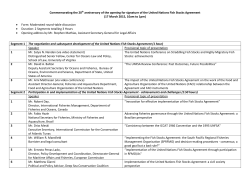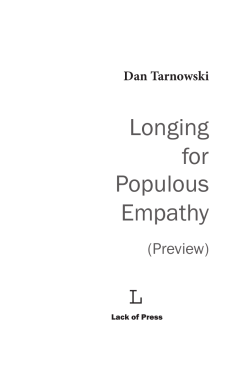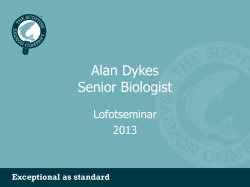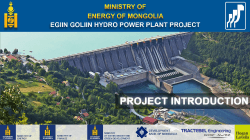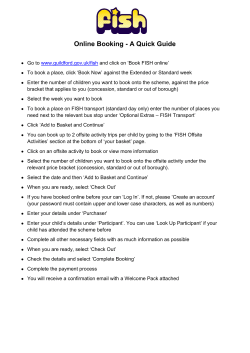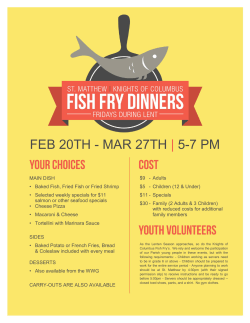
Fish Conservation and Management
Fish Conservation and Management CONS 486 Instructor: Scott Hinch TA: Vanessa Minke-Martin Welcome to CONS 486! • Introduction, key concepts • Course themes, objectives & goals • Course structure & requirements – Seminar and written review assignments • Contact information 2 Introduction and Key Concepts What’s all the fuss about fish? • Defining a fish: an aquatic animal with gills that lacks limbs with digits • First appeared 530 MYA during Cambrian explosion • Incredible diversity – 32K+ described species • Fish are taxonomically diverse: – Includes class Agnatha (jawless) – Chondrichthyes (cartilaginous) – Osteichthyes (bony fish) • Actinopterygii (rayed fins) & Sarcopterygii (lobed fins) – Extinct classes (e.g., Placodermi) 4 Class Agnatha: Pacific hagfish (Eptatretus stoutii) Atlantic hagfish J.P. Hastey UBC (Myxine glutinosa) 5 Class Agnatha: River lamprey (Lampetra fluviatilis) 6 Pacific lamprey (Entosphenus tridentatus) 7 Chondrichthyes: Great white shark (Carcharodon carcharias) 8 Class Actinopterygii: Yellowfin tuna (Thunnus albacares) 9 Class Sarcopterygii: coelacanth (NOT extinct!) 10 Smithsonian Class Placodermi (now extinct) • Bony plated fish • One of the first jawed fish species • In contrast to the agnathans • Note the heterocercal tail like sturgeon and sharks! 11 Of Fish and Fisheries… • What IS a fishery? • A romanticized view: “a fishery is the union of aquatic organisms and humans” (Miller and Johnson 1989) • Three components to a fishery: 1. Aquatic resource itself (i.e, targeted organism) 2. Aquatic environment (i.e., habitat) 3. Humans that harvest resource OR change habitat • Fisheries target more than just fish! – Molluscs (bivalves, snails); crustaceans (lobsters, crabs); sea urchins; sponges; other inverts; not to mention 12 bycatch Commercial fisheries • Fish caught for sale – Methods: nets, hook-and-line, traps, etc. 13 Recreational fisheries • Fish caught for sport – Methods: hook-and-line, spear, bow-and-arrow… 14 Subsistence fisheries • Fish caught for food – Methods: all of the above and more… Nat Geo 15 Fish production • Aquaculture: i.e., farming fish, crustaceans, molluscs 16 Fish production • Hatcheries/stocking: some to enhance, some to create 17 100 Marine Freshwater Million tonnes 80 60 40 20 0 Half again (~48 million T) from aquaculture (fao.org) Estimated 47 billion individual fish landed annually in recreational fisheries (Cooke and Cowx 2004) Over 3 TRILLION individual fish per year from fisheries alone, excluding aquaculture! 1950 1960 1970 1980 1990 2000 World wild commercial fish harvest (adapted from fao.org) 18 Conservation and Management Definitions and philosophies What is conservation science? • Conservation science: “addresses the biology of species, communities, and ecosystems that are perturbed, either directly or indirectly, by human activities or other agents” (Soulé BioScience 1985) – Goal to provide principles and tools for preserving biological diversity • Integrative, multi-disciplinary field of study • Many sub-disciplines such as conservation genetics, conservation physiology, restoration ecology, urban ecology 20 What is fisheries management? • Fisheries management: aims to maintain a “…sustainable fishery resource that provides for an economically viable and diverse industry” (DFO 2014) – Management based on “credible, science-based, affordable and effective practices” (DFO 2014) – Fisheries management applies to all programs that manipulate people-fish interactions • Why conservation AND management? 21 Conservation and management • Protection and conservation of fisheries resources are a key component of fisheries management • Integrating the terms: “the manipulation of human interactions with living aquatic resources in a manner that allows humans to gain some sustainable benefit from these resources” (Nielsen 1993) • Can mean the manipulation of: 1. Resources themselves (e.g., population enhancement or stocking) 2. Environments (e.g., restoration) 3. Human behaviour (e.g., harvest regulations) 22 Course Themes and Objectives Course goals and overview Major theme: Linking science to conservation & management • • • • • Physiology Behaviour Population ecology Ecosystem ecology Habitat data (limnology, oceanography) • Life history • Protecting populations & habitats • Restoring populations & habitats Basic science Applied science Conservation Management • Fisheries exploitation data • Applied life history data • Human dimensions: socioeconomic data • Harvest regulations • Managing fisheries & habitats 25 CONS 486! • The goal of this course is to provide an introduction to fish conservation and management by: 1. Examining principles of basic and applied fish biology, including physiology, behaviour, and ecology; 2. Overviewing current issues, common tactics and institutions involved in fish conservation & management; 3. Reviewing case studies that demonstrate conservation & management successes and failures 26 Lecture schedule 1. First part of course on fish biology/ecology 2. Second part of course on fisheries management and conservation 3. Third part of course dedicated to case studies and guest lectures – Kristi Miller (DFO Research Scientist) – Eric Parkinson (BC MoE Emeritus Scientist) 4. Fourth part of course dedicated to student-led seminars and facilitated discussion! 27 Course Requirements Evaluation • • • • Seminar presentation: 20% Written review: 20% Seminar participation: 20% Final exam: 40% (during formal exam period) Note: late submissions are docked 10% per day 29 Readings • Readings for lectures: – On reserve in library, or see your TA for selected copies 1. Ross, M.R. 1997. Fisheries Conservation and Management. Prentice 2. Diana, J. 1995. Biology and Ecology of Fish. Cooper Publishing • Others will be assigned during the term – Required readings of ALL seminar topic papers • Please read carefully and prepare discussion points for seminars – Additional optional readings on reserve or ask us! 30 Seminar and Written Review Discussion Student-led seminars • In groups of 3: research a topic by focusing on a key scientific paper – Seek out additional references (min 10) that support or refute the key paper • Deliver a presentation to the class that: – Reviews the general topic, then summarizes the key paper’s objectives and findings – Critical review of the paper – Facilitates a class discussion (i.e., generate a short list of relevant questions to pose to the class) • 50 min presentation – 30 minute presentation; ~15-20 minute questions • Active participation required by all! • Seminars start Feb 23 – 1 seminar per hour of class 32 Written review • Essay should include: 1. A discussion & critical review of the general topic 2. A summary of the key paper’s objectives and findings 3. Cite 10-20+ relevant references from the peer-reviewed scientific literature (the more, the better) • All statements of fact or others’ opinions must be referenced • ~15-20 pgs total length, single-spaced, including tables/figures/references • Each written review is to be handed in on the day of the oral seminar presentation on that topic – Written reviews must be developed independently! 33 Seminar topic selection 1. 2. 3. 4. Groups of 3… we’re all friends here! Look over the seminar topics (see hand-out) Discuss your favourites with your partners Together, rank your top choices in order from 1-5 – 1 being your favourite choice 5. Hand in (one copy per pair) the seminar list with your top choices (and your names!) 6. We will crunch the numbers and reveal your topics next class 34 • Course web site: http://faculty.forestry.ubc.ca/hinch/DD_CONS_486.html • Instructor: Dr. Scott Hinch (Rm 3022 FSC; scott.hinch@ubc.ca) • TA: Vanessa Minke-Martin (Rm 3627 FSC; vmmartin@alumni.ubc.ca) • Please contact us by e-mail to arrange in-office meetings 35
© Copyright 2025

